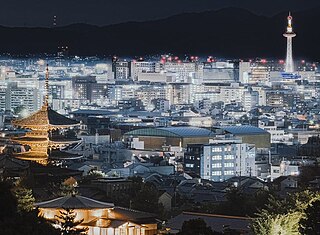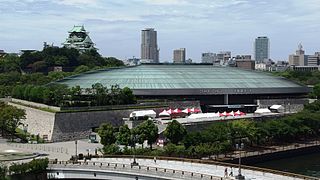Kyōbashi may refer to:
- Kyōbashi, Tokyo
- Kyōbashi Station (Osaka), in Osaka
- Kyōbashi Station (Tokyo), in Tokyo
Kyōbashi may refer to:

The Osaka Loop Line is a railway loop line in Japan operated by the West Japan Railway Company. It encircles central Osaka.

Ginza is a district of Chūō, Tokyo, located south of Yaesu and Kyōbashi, west of Tsukiji, east of Yūrakuchō and Uchisaiwaichō, and north of Shinbashi. It is a popular upscale shopping area of Tokyo, with numerous internationally renowned department stores, boutiques, restaurants and coffeehouses located in its vicinity. It is considered to be one of the most expensive, elegant, and luxurious city districts in the world.

The Yamatoji Line is the common name of the western portion of the Kansai Main Line. The line is owned and operated by West Japan Railway Company, and starts at Kamo Station in Kyoto Prefecture and ends at JR Namba Station in Naniwa-ku, Osaka.

Kyōbashi (京橋) is a neighborhood east of Tokyo Station in Chūō, Tokyo, Japan. It is one of the city's oldest commercial districts, although it has since been eclipsed by Ginza to the south and Nihonbashi to the north. Kyobashi, together with Nihonbashi and Kanda, is the core of Shitamachi, the original downtown center of Edo-Tokyo, before the rise of newer secondary centers such as Shinjuku and Shibuya.

The Hanwa Line is a commuter rail line in the Osaka-Kobe-Kyoto Metropolitan Area, owned and operated by West Japan Railway Company. The 61.3 km line runs between Osaka and Wakayama, Japan and has a 1.7 km branchline in a southern Osaka suburb. The name is taken from the second syllable of Osaka and the first syllable of Wakayama.
Kyobashi Station is a railway station in the Kyōbashi district of Jōtō-ku and Miyakojima-ku, Osaka, Japan, jointly operated by West Japan Railway Company, the private railway operator Keihan Railway, and the Osaka Metro.

Chūō is a special ward that forms part of the heart of Tokyo, Japan. The ward refers to itself in English as Chūō City. It was formed in 1947 as a merger of Kyobashi and Nihonbashi wards following Tokyo City's transformation into Tokyo Metropolis.

Keihanshin is a metropolitan region in the Kansai region of Japan encompassing the metropolitan areas of the cities of Kyoto in Kyoto Prefecture, Osaka in Osaka Prefecture and Kobe in Hyōgo Prefecture. The entire region has a population of 19,302,746 over an area of 13,228 km2 (5,107 sq mi). It is the second-most-populated urban region in Japan, containing approximately 15% of Japan's population.

Kyobashi Station is a subway station on the Tokyo Metro Ginza Line in Chūō, Tokyo, Japan, operated by the Tokyo subway operator Tokyo Metro. It is numbered "G-10".

Nihonbashi (日本橋) is a business district of Chūō, Tokyo, Japan which grew up around the bridge of the same name which has linked two sides of the Nihonbashi River at this site since the 17th century. The first wooden bridge was completed in 1603. The current bridge, designed by Tsumaki Yorinaka and constructed of stone on a steel frame, dates from 1911. The district covers a large area to the north and east of the bridge, reaching Akihabara to the north and the Sumida River to the east. Ōtemachi is to the west and Yaesu and Kyobashi to the south.

The Katamachi Line, officially nicknamed the Gakkentoshi Line, is a commuter rail line and service in the Osaka-Kobe-Kyoto Metropolitan Area of Japan, owned and operated by West Japan Railway Company. The line connects Kizu Station in Kyoto Prefecture and Kyōbashi Station in Osaka.

Higashi-Umeda Station is a railway station on the Osaka Metro Tanimachi Line in Umeda, Kita-ku, Osaka, Japan. The station is located along Whity Umeda.

The JR Tōzai Line is one of several commuter rail lines and services in the Osaka-Kobe-Kyoto Metropolitan Area, operated by West Japan Railway Company. The line, whose name literally means "east-west", runs underground through central Osaka and connects the Gakkentoshi Line at Kyobashi Station in Osaka and the JR Takarazuka Line and the JR Kobe Line at Amagasaki. All stations on this line are in the city of Osaka, except for the western terminus in Amagasaki, Hyōgo Prefecture.
This page lists Japan-related articles with romanized titles beginning with the letter K. For names of people, please list by surname. Please also ignore particles when listing articles.

The bombing of Osaka during World War II first took place from the middle of the night on March 13, 1945, to the early morning of the next day. There were also bomb raids on June 1, 6, 7, 15, 26, July 10, 24, and August 14, the last day of the war. It is said that more than 10,000 civilians died in these bombings in Osaka, Japan.

Jōtō-ku is one of the 24 wards of Osaka, Japan. "Jōtō" means "east of the castle", referring to Osaka Castle. It was separated from Higashinari and Asahi in 1943, and eastern Jōtō became Tsurumi in 1974. Jōtō-ku has the highest population density of any ward in a city-designated municipality in Japan, and is the only ward with a density that exceeds 20,000 people per square kilometre. When the special wards of Tokyo are also included, it is the sixth densest ward in the country after Toshima, Nakano, Arakawa, Bunkyō and Taitō. In recent years, there has been increased construction of high-rise condominiums in the western and northern parts of the ward, and the population of Jōtō-ku continues to grow.

Osaka-jō Hall is a multi-purpose arena located in the Kyōbashi area of Osaka, Japan. The hall opened in 1983 and can seat up to 16,000 people. Built on a site area of 36,351 square meters, part of its form uses stone walls, modeled after those of the Castle and it won the Osaka Urban Scenery Architects Prize Special Award in 1984.

Takarachō Station is Station A-12 on the Toei Asakusa Line of the Tokyo Subway network in Japan. It is located underground in the Kyōbashi neighborhood of Chūō, Tokyo.
Events in the year 1907 in Japan.

The National Film Archive of Japan is an independent administrative institution and one of Japan's seven national museums of art, which specializes in preserving and exhibiting the film heritage of Japan. In its previous incarnation, it was the National Film Center, which was part of the National Museum of Modern Art, Tokyo. In April 2018, it became independent of the National Museum of Modern Art and was officially elevated to the rank of a national museum.